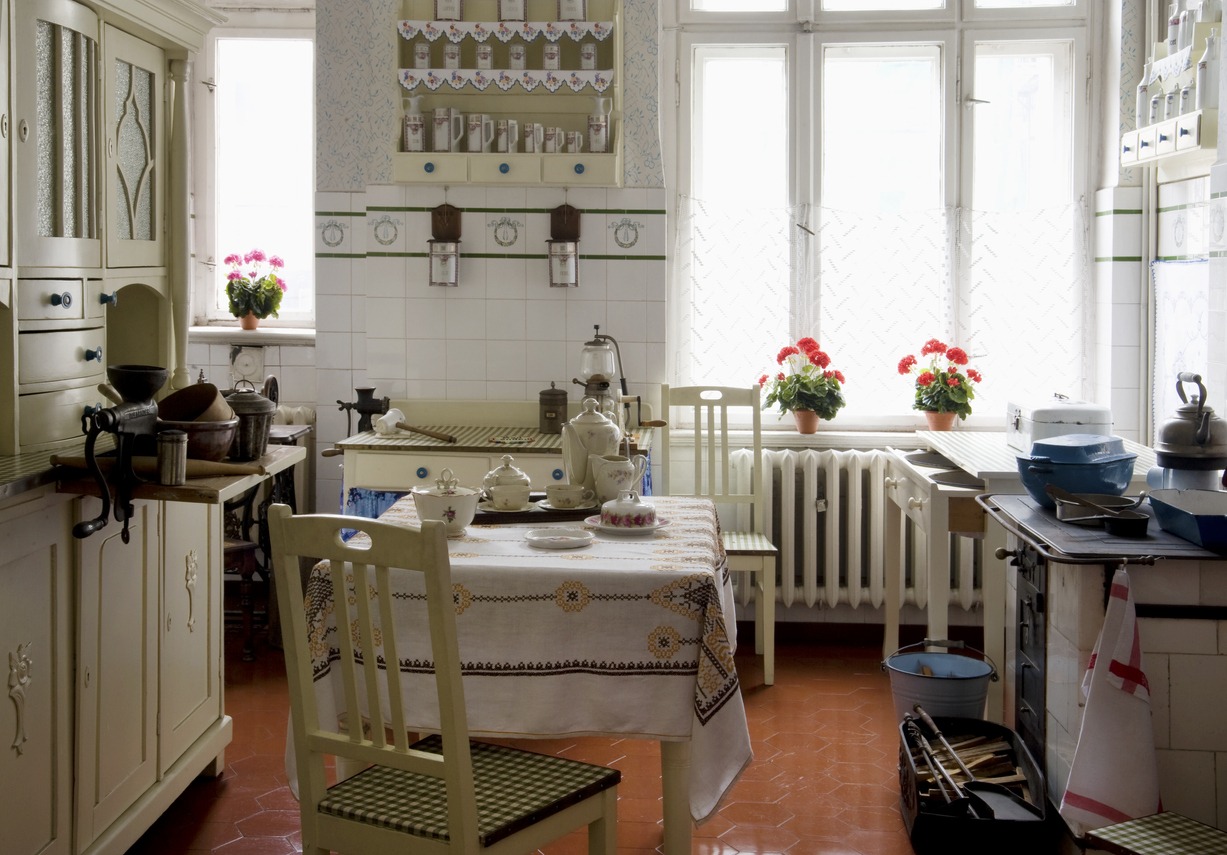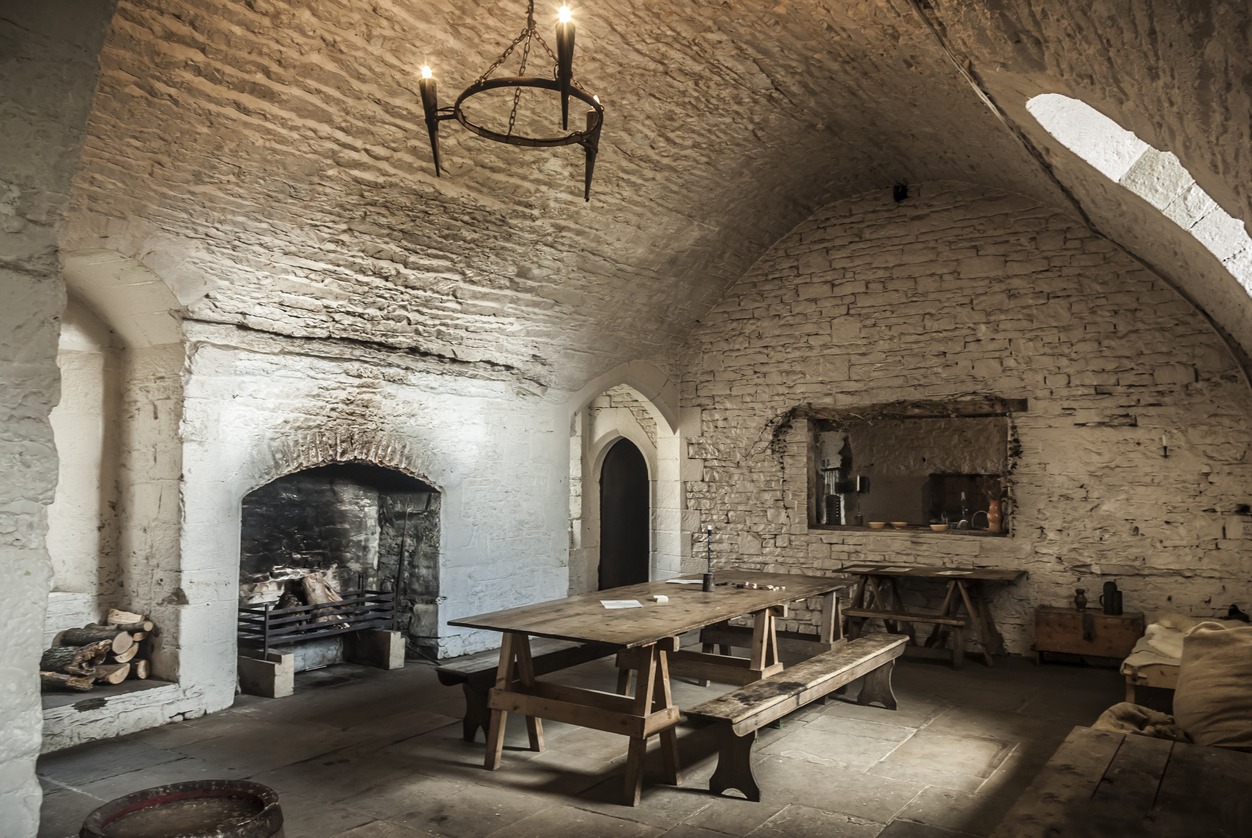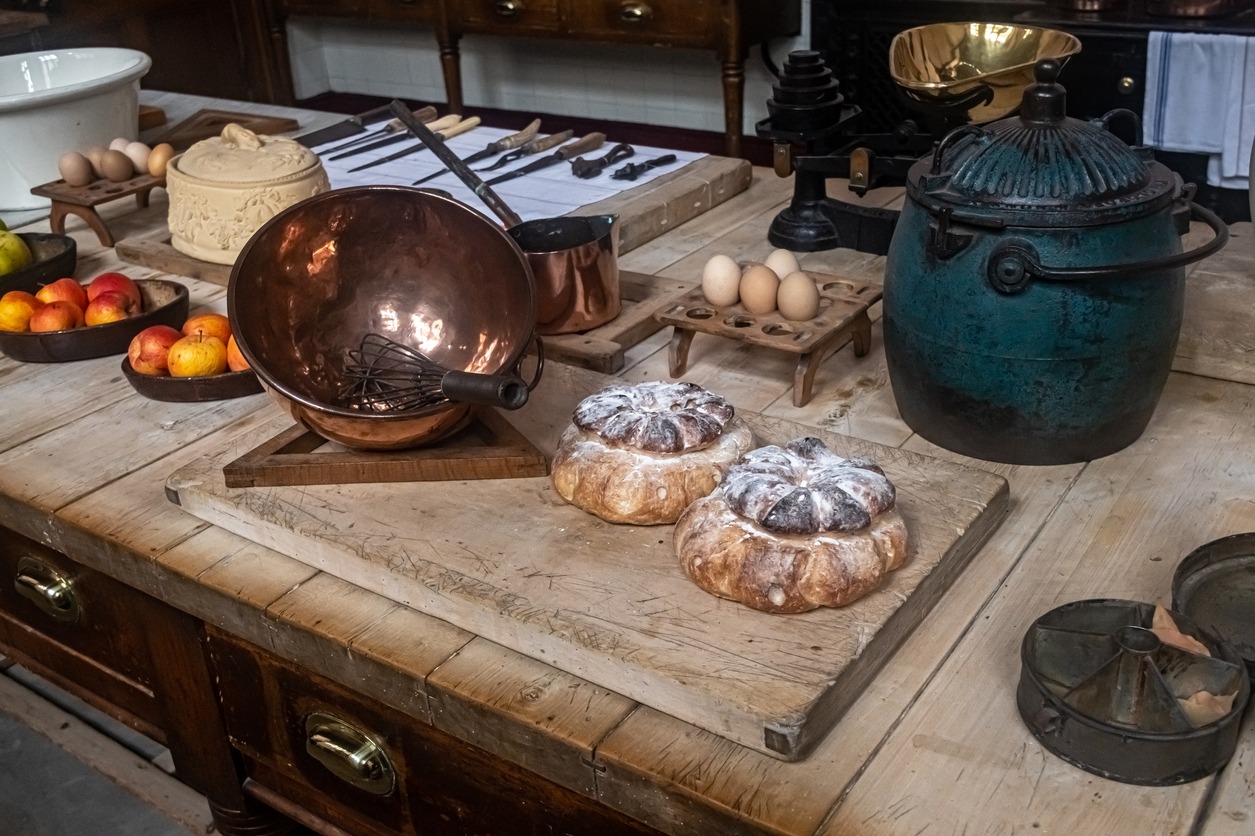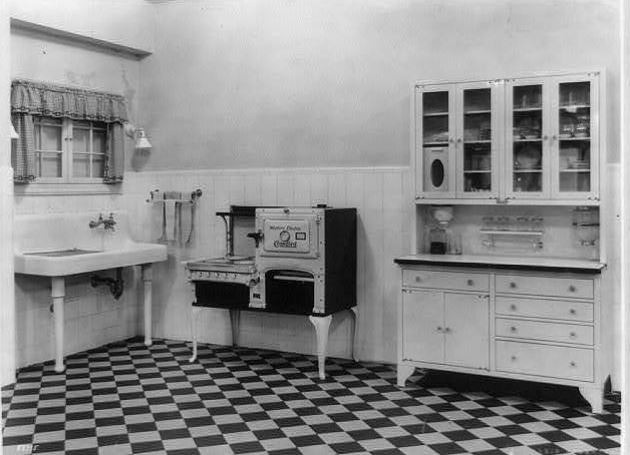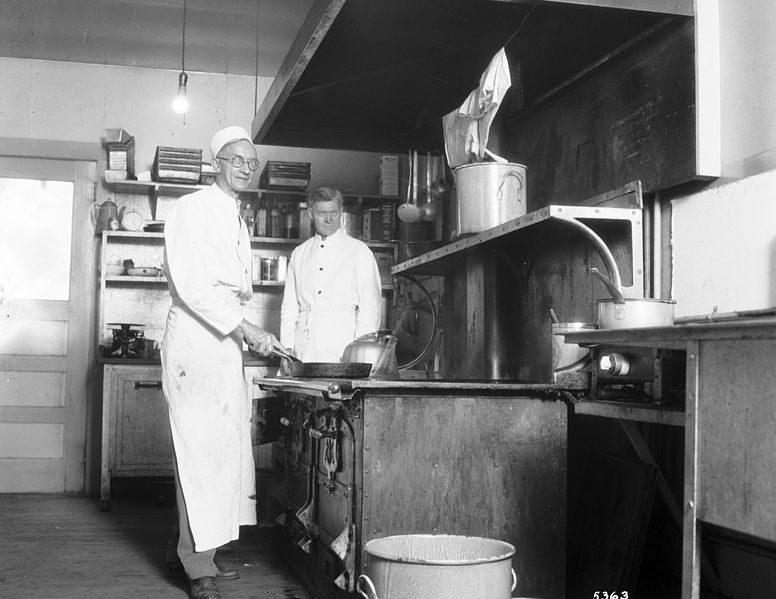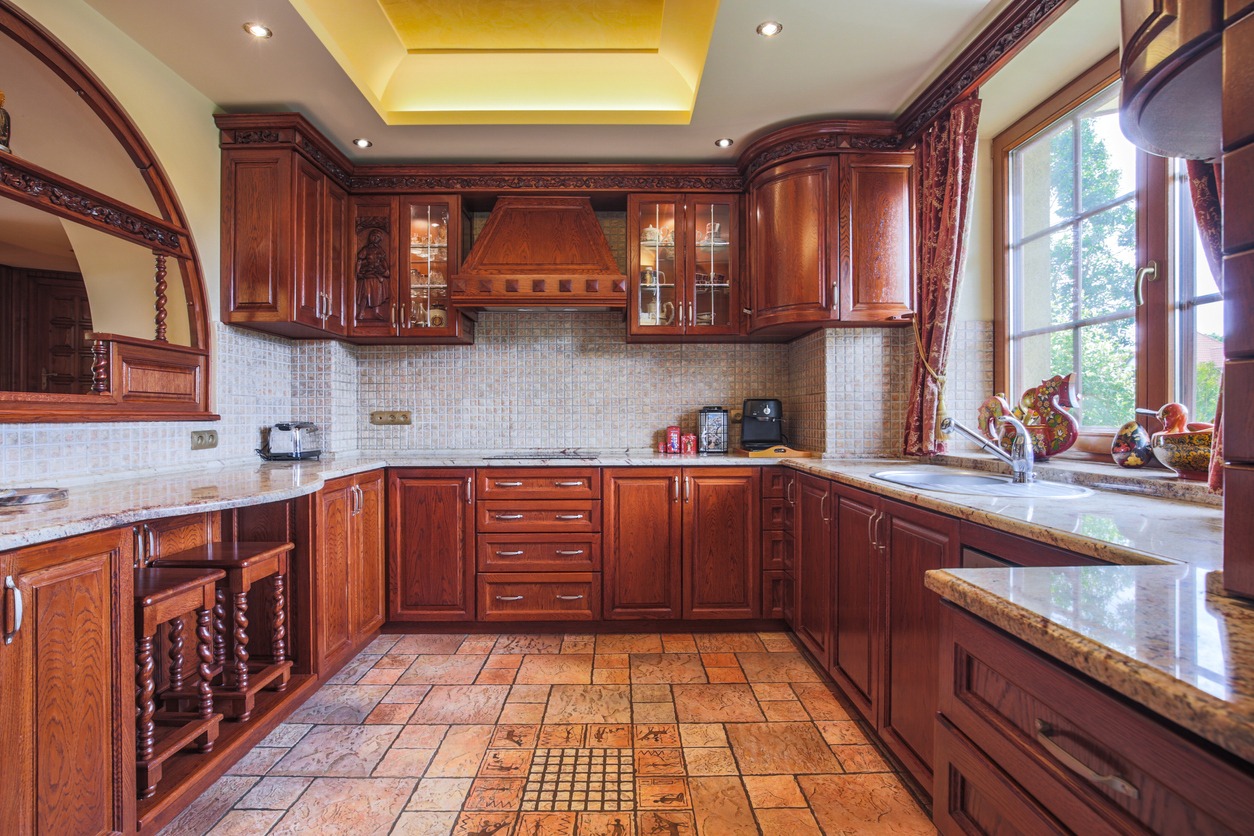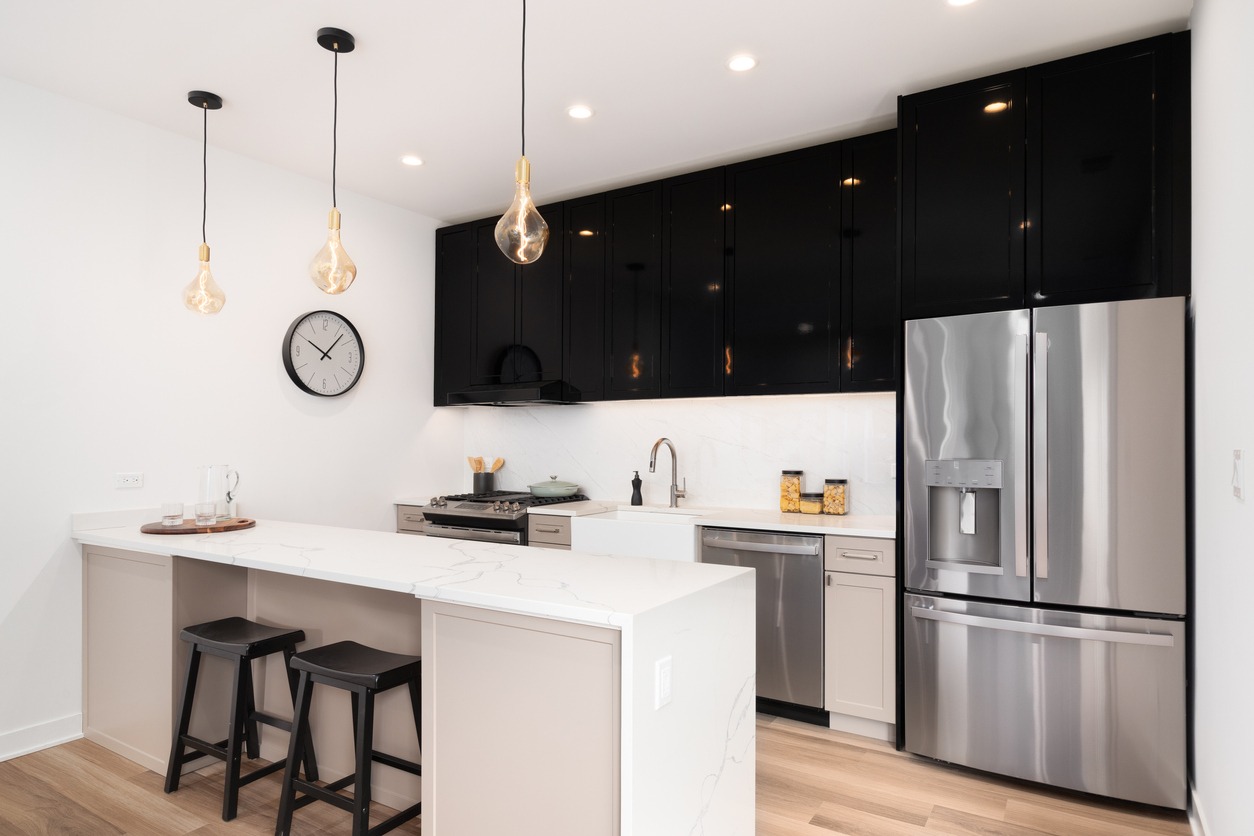Since the dawn of cooking, humans needed a place to prep their meals. While we rarely ponder the history of countertops, they’ve played a crucial role in our culinary lives. Today, continuous countertops are so common that it’s hard to imagine a kitchen without them.
However, at the beginning of the 20th Century, they were a novel design element found only in a select few kitchens. Early kitchens centered around a stone hearth by the fire, which served as a makeshift countertop. As time passed, kitchen designs progressed, and cooks transitioned from hearths to dedicated kitchen spaces. Here’s what you may want to know about the history of kitchen countertops:
Ancient Times to the Renaissance
The history of kitchen countertops can be traced back to ancient times, with countertops evolving significantly over the centuries.
One of the earliest forms of countertops can be traced back to ancient Egypt, where they used large slabs of stone, such as limestone or granite, as flat surfaces for preparing food. The ancient Romans also used stone, including marble and travertine, as a surface for food preparation.
During the Middle Ages, kitchens in European castles and manors often had wooden countertops, which are basically big tables in the kitchen used for food preparation. These were often made from large wooden slabs, like oak or maple. In the Renaissance era, kitchen countertops began to take on more ornate and decorative designs, reflecting the architectural and design trends of the time. If you want to know about the diet and cooking methods that were common during the Renaissance, read the History of Renaissance Cooking.
Victorian Era (1800s to early 1900s)
Countertops were purely functional until the 1800s, serving as practical work surfaces. Kitchens during this period were often what we now call “unfitted” kitchens. They lacked built-in cabinetry and instead featured freestanding kitchen furniture. Typically, these kitchens had a worktable, a dough table, and perhaps a Hoosier (a standalone piece of furniture). These freestanding pieces typically had wooden tops. Houses with butlers’ pantries might have built-in dressers for holding serving dishes, but even then, the countertops were usually made of wood. In addition to oak and maple, other hardwoods like cherry and walnut became popular choices.
Besides fine wood, upscale kitchens began to embrace other opulent materials like marble and even metal. These lavish materials were typically reserved for areas like pantries or serving spaces where guests would gather. The main kitchen, however, was primarily constructed for durability with little consideration for aesthetics. Nevertheless, this marked a significant shift in the history of countertops.
As the 20th Century dawned, society began to focus on the connection between germs and disease, leading to what we now call the “Sanitary Movement.” This movement influenced kitchen design, with a growing emphasis on easily cleanable surfaces and the visibility of hidden dirt. White subway tiles started appearing on walls to meet these hygiene concerns. Wooden surfaces were still common on built-in dressers, but tiles began to make an appearance on dresser countertops. The tiles of that era had sharp edges and tight grout lines to prevent dirt or germs from hiding.
With the development of new technologies and materials, kitchen trends underwent a significant transformation. In the early 1900s, metals like stainless steel and nickel gained popularity, marking a departure from traditional materials. These metals were prized for their durability and resistance to staining.
Porcelain enamel over cast iron became a popular countertop material during the early 20th Century. These countertops were durable and easy to clean, but they could chip or crack if heavy objects were dropped on them. For more information on the cooking methods during the Victorian era and other time periods, check out the History of Cooking. Besides kitchen countertops, the Victorian era also had a large influence in the evolution of bedrooms. If you want to know more, check out The History of the Bedroom.
1920s
The 1920s brought a shift in kitchen design as household dynamics changed. Before then, millions of people in Britain worked as domestic servants, and for those who couldn’t afford servants, a separate kitchen was often out of reach. But during this era, more women took on the role of preparing family meals, requiring fewer servants. There was a growing need for increased kitchen storage. While freestanding furniture kitchens were still common, pre-made modular cabinetry became available, and site-built cabinetry also gained popularity.
It was during this time when kitchen worktops were introduced, although they didn’t take up as much space as they do in modern kitchens. You might notice a section of the worktop near the sink or even a china cabinet that evolved to include a small workspace between the upper and lower cabinets. These early worktops were often made of wood and didn’t always have built-in cabinets underneath, giving them an almost floating appearance to our modern eyes.
In terms of countertop materials, tile with tightly spaced grout lines remained a popular choice. However, the 1920s introduced vibrant and attractive colors to the kitchen. Tiles came in delightful color combinations like green and yellow, green and orange, yellow and blue, or white and blue. Hexagonal or small square tiles were common, and the grout lines were always tight, unlike the wider grout lines and eased edges we typically see with modern tile.
Some 1920s tile countertops featured a marble drop-in section for tasks like pastry-making or candy preparation, but the majority of counters were tile-based. Zinc was occasionally used to cover wooden surfaces in pullouts on Hoosier cabinets, and institutional kitchens might have had wood counters covered with a metal called Monel (an alloy of nickel, copper, and iron). However, these treatments were rare in home kitchens, and budget-conscious individuals sometimes used bits of linoleum as countertop material.
1930s
Compared to 1920s kitchens, those of the 1930s bore a striking resemblance to the modern kitchens we’re familiar with today. In a 1930s kitchen featured in Antique Home Style (also shown in the lead image above), built-in cabinets stretched seamlessly across uninterrupted countertops. The stove and sink were seamlessly integrated into the countertop, even including clever cutting board storage that would make a handy addition to any home.
During this period, kitchen advertisements, if not actual kitchens, began to embrace the emerging trend of the “fitted” kitchen. In 1943, the Libbey-Owens-Ford company enlisted H. Creston Dohner to create a model kitchen called the ‘Kitchen of Tomorrow.’ This innovative kitchen was displayed in various department stores across the country and caught the eyes of an estimated 1.5 million people.
While not all of its innovations (like the built-in waffle maker and foot pedal-operated sink) became mainstream, the Kitchen of Tomorrow played a pivotal role in establishing the Bauhaus-inspired concept of sleek, uninterrupted countertops as the standard for a modern kitchen. Naturally, this didn’t mean that everyone rushed out to replace their existing kitchens immediately, but it set the stage for the new look of kitchens, and there was no turning back.
In the 1930s, tile continued to dominate as the most common countertop material for homes. However, there were advancements with materials like Melamine and plastic laminates, now known as Formica. In upscale kitchens, you might occasionally find Monel on countertops, although it was pricey and mostly used in commercial settings.
Post-War Era (1940s-1960s)
In the United Kingdom, the aftermath of the Second World War brought about a significant shift. Young women, who had traditionally become domestic servants, now had alternative opportunities. Consequently, even the middle and upper classes began taking on their own cooking and cleaning responsibilities, leading to a growing demand for improved kitchens. The reconstruction of homes damaged by bombings and urban slum clearance in the 1950s and 1960s resulted in more ordinary family homes with dedicated kitchens designed for family use.
As rationing ended and consumerism gained momentum, Britons looked to the United States for design inspiration. American kitchens, with their larger layouts and economic prosperity, became models to admire, and they all featured essential worktops. Wood remained a popular choice for worktop material, but newer options like vinyl and linoleum also entered the scene.
As kitchen design shifted its focus from creating efficient spaces for grand estates to ordinary family homes, kitchen worktops came into their own. Kitchen worktops not only provided an effective workspace but also enhanced kitchen storage in an appealing manner. As gadgets and appliances evolved, kitchen counters adapted to accommodate and conceal them. From early electric kettles and twin-tub washing machines to modern microwaves and tumble dryers, these handy gadgets replaced the need for traditional servants.
During the 1940s, tile continued to dominate as a popular choice for home. However, there were shifts in color palettes, V-Cap profiles, and pattern designs reflective of the era. Hexagonal and square tiles were once again the top choices, with square tiles occasionally arranged diagonally to create eye-catching diamond patterns.
Formica became more popular as a countertop material in the post-war era. Formica introduced a vibrant array of colors and playful designs, featuring elements like boomerangs, cracked ice, starbursts, burlap, or amoebas. The metal edging on Formica counters also gained texture, adding an extra layer of design flair. Linoleum countertops were still around, but they were often chosen for budgetary reasons. Stainless steel countertops also gained popularity in commercial kitchens during this time due to their durability and resistance to heat and stains.
Soapstone occasionally made appearances on the East Coast in the 1950s, as it’s native to that region. It was used for both kitchen and utility sinks and sometimes as the surface for work tables. However, soapstone is quite hard, so butlers’ pantries typically feature wooden counters with copper sinks to protect delicate dishware. The kitchen sink wasn’t where you’d wash fine china.
During the 1960s, laminate materials like Formica were the epitome of style. Bright and daring colors, such as vibrant yellow, lime green, and hot pink, were frequently used in fashion countertops during this period.
1970s-1990s
Granite experienced a surge in popularity during the 1970s, a trend that still continues today, albeit not as pronounced as it was five decades ago. Granite has maintained a lasting presence in kitchens and bathrooms, becoming a staple in modern homes. It graces kitchen islands, countertops, and bathroom fixtures.
While granite was utilized in luxury homes as early as the 1920s, it truly became the mainstream choice for countertops in the 1970s. Granite remains a favored option among homeowners due to its irresistible allure that cannot be replicated, with each granite slab possessing a unique character.
In the 1980s, ceramic tile made a significant entrance. It offered a cost-effective option with an abundance of color choices, making it an attractive pick for homeowners during that period. Tile countertops gained popularity due to their affordability and ease of installation. While tile countertops still exist in many homes, their prevalence has decreased over time. However, tile isn’t an ideal choice for countertops because grout tends to stain easily and can harbor bacteria.
Solid surface countertops, often colloquially referred to as “Corian” due to the widespread popularity of Corian brand countertops, started gaining traction in the 1980s and continued their ascent through the ’90s. Corian was first introduced during the 1960s but only gained popularity more than 20 years later.
The 1990s witnessed a surge in the use of solid-surface countertops, particularly Corian. These countertops mimic the appearance and characteristics of natural stone without the hefty price tag. Black emerged as the preferred countertop color during the 1990s and persisted into the early 2000s. Black countertops brought a sense of boldness and elegance to both classic and modern kitchen or bathroom designs.
21st Century
The early 2000s saw the rise of engineered stone, commonly known as quartz, in countertop choices. What made them particularly appealing was their affordability compared to real stone. This made quartz a viable and upscale option for homeowners aiming to modernize their kitchens to align with the aesthetics of the new decade.
Quartz was invented in 1963. This material proved to be both durable and aesthetically pleasing, suitable for various surfaces. It found a particularly well-suited application in quartz kitchen countertops. An Italian inventor developed a patented method for engineering quartz, and soon, it was replicated by many companies, producing their own quartz material. Quartz wasn’t popular yet during that time, but the 60s set the stage for this well-beloved, modern countertop material.
With advancements in technology and 3D printing, manufacturers managed to create quartz countertops that closely resembled natural and unique granite. Quartz came in a variety of colors and finishes, ranging from textured leather to sleek polished surfaces. While black countertops remained in vogue during the early 2000s, lighter shades like beige, gray, and white gained popularity in the latter part of the decade.
From the 2010s to the present, natural stone has become more desirable, although engineered stone remains a popular choice. Quartz continues to lead the way in countertop trends from the 2010s to the present. Preferred color choices include Carrara white, gold, and grey.
Today’s homeowners lean towards a clean and modern aesthetic. Countertops used to be the focal point, bold and dominating, whereas now they serve more as accent pieces. Because of that, other materials like concrete, butcher block, and glass have also found their way into contemporary kitchen designs.
Today, kitchen countertops come in a wide variety of materials and styles, catering to both functional and aesthetic preferences. Advances in technology and manufacturing have expanded the choices available to homeowners, allowing for greater customization and design possibilities in the kitchen.
